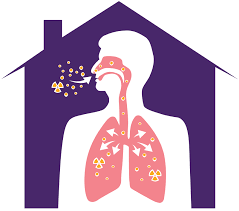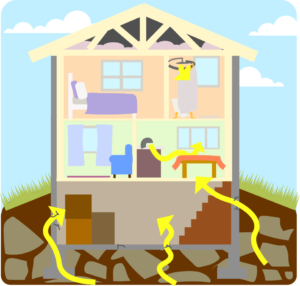Radon Facts
Radon is a naturally-occurring radioactive gas which is a part of the uranium-238 decay chain. The immediate parent of radon-222 is radium-226. Radon comes from the breakdown (radioactive decay) of uranium that is found in soil and rock all over the United States.
Radon is a component of the air in soil that enters buildings through cracks and other pathways in the foundation. Eventually, it decays into radioactive particles (decay products) that can become trapped in your lungs when you inhale. As these particles decay in tum, they release small bursts of radiation.

This radiation can damage lung tissue and lead to lung cancer over the course of your lifetime. EPA studies have found that radon concentrations in outdoor air average about 0.4 pCi/L (picocuries per liter) of air. However, radon and its decay products can reach much higher concentrations inside a building.
Radon gas is colorless, odorless, and tasteless. The only way to know whether
elevated concentrations of radon are present in any building is to test.
Radon Health Effects
Radon is a known human carcinogen. Prolonged exposure to elevated radon concentrations causes an increased risk of lung cancer. Like other environmental pollutants, there is some uncertainty about the magnitude of radon health risks. EPA calculates that radon may cause 21,000 lung cancer deaths in the United States each year.
The U.S. Surgeon General has warned that radon is the leading cause of lung cancer deaths in non-smokers in the United States. Only smoking causes more lung cancer deaths than radon.
Not everyone who breathes radon decay products will develop lung cancer. An individual’s risk of getting lung cancer from radon depends mostly on three factors:
- the concentration of radon,
- the duration of exposure and the
- individual’s smoking habits.
In addition, some people are more susceptible to lung cancer than others.
Risk increases as an individual is exposed to higher concentrations of radon over a longer period of time. Smoking combined with radon is an especially serious health risk. The risk of dying from lung cancer caused by radon is much greater for smokers than it is for non-smokers.
Radon Exposure
Because many people spend much of their time at home, the home is likely to be the most significant source of radon exposure. According to EPA, nearly l out of every 15 homes in the United States is estimated to have radon concentrations that exceed the EPA action level.

Elevated concentrations of radon have been found in homes and buildings in every state. While elevated radon may be more common in some areas, any building can have a problem.
If you live or are buying in areas that are red or orange on the map of NJ, we recommend you test for high levels of radon exposure.
EPA recommends that ALL buildings should be tested regardless of the area of the country and that maps should not be used to determine whether to test. More specific information on the likelihood of elevated radon in your area can frequently be found at your state or county radon offices.
The concentration of radon in the air within a building should be reduced below EPA’s radon action level of 4 pCi/L. Any radon exposure creates some risk; no concentration of radon is safe.
Even radon concentrations below 4 pCi/L pose some risk, and the risk of lung cancer can be reduced by lowering indoor radon concentrations. This action level is based largely on the ability of current mitigation technologies to consistently reduce radon concentrations below 4 pCi/L. Depending on the building characteristics, radon concentrations in some buildings can be reduced well below 4 pCi/L. In others reducing radon concentrations to below 4 pCi/L may be more difficult.
Radon Entry into Buildings
Radon in soil gas is the main source of radon problems. Pathways for radon to enter a building include cracks in the slabs and walls, the expansion joints between floor and walls , porous concrete block walls, open sump pits, crawlspaces and openings around utility penetrations. Some buildings have other pathways for radon to enter a building such as sub-slab utility tunnels and heating, ventilating and air conditioning (HVAC) ducts.

Radon gas can also enter buildings in well water. Though less commonly a concern, radon from well water used in a building can off-gas and raise the concentrations. For dwellings or small communities serviced by well water, a test of the water for radon should be considered. For more information on testing radon in drinking water, contact your state radon office.
Sometimes building materials that contain uranium and radium can produce radon. A radiation professional or your state radiation program can help you evaluate this possibility.
Factors Influencing Radon Entry
Many factors contribute to the entry of radon gas into buildings. As a result, residence managers cannot know without testing if elevated concentrations of radon are present in their building complex. The following factors determine why some buildings have elevated radon concentrations and others do not:
- The concentration of radon in the soil gas (source strength);
- The permeability of the soil or sub-surface geology (gas mobility) under the building;
- The structure and construction of a building; and,
- The type, design, operation, and maintenance of the heating, ventilating and air-conditioning (HVAC) system.
Source strength: The radon concentration in soil gas can vary greatly from building to building. It can even vary greatly under different parts of the same building.
Gas mobility : Certain geological features beneath a building, such as cracks, fissures, or solution cavities, can serve as a direct connection between the radon-producing minerals and the building’s foundation. Such a direct connection can cause-one unit of a building to have a radon concentration significantly higher than other units in the area. The permeability of the soil under a building, along with the differences between the air pressure inside a building and the air pressure under a building’s foundation influence the rate at which radon enters a building. For example, if the air pressure in the building is greater than the air pressure under the building’s foundation, radon should not enter through the openings of a building’s foundation. If the air pressure in the building is less than the air pressure under the building’s foundation, radon in the soil gas will enter through any openings in the building’s foundation.
Structure and construction: Any building design can have a radon problem. Without testing, you cannot know if elevated concentrations of radon are present.
Heating, cooling and ventilation systems (HVAC): Depending on their design and operation. HVAC systems can influence radon concentrations in buildings:
- Fresh air ventilation serves to dilute indoor radon concentrations with outdoor air; however radon’ s source strength commonly overwhelms the practical limits of increasing ventilation to reduce occupant exposure.
- Poor ventilation provides less dilution to indoor radon concentrations.
- Depressurized buildings draw radon inside.
- Pressurizing a building helps keep radon out.
The frequency and thoroughness of HVAC maintenance can sometimes play an important role. For example, air intake filters that are not periodically cleaned and changed can significantly reduce the amount of outdoor air ventilating the indoor air environment. An understanding of the design, operation, and maintenance of a building’s HVAC system and how it influences indoor air conditions is helpful for understanding and managing a radon problem, as well as many other indoor air quality concerns in buildings. However, since HVAC systems are only one of many factors that affect radon concentrations in a building, HVAC system modifications alone are often not an effective radon mitigation strategy.
Contacts for Additional Information
- EPA website https://www.epa.gov/radon
- State radon offices: https://www.epa.gov/radon/find-information-about-local-radon-zones-and-state-contact-information
- Regional EPA offices: https://www.epa.gov/aboutepa/epa-organization-chart


